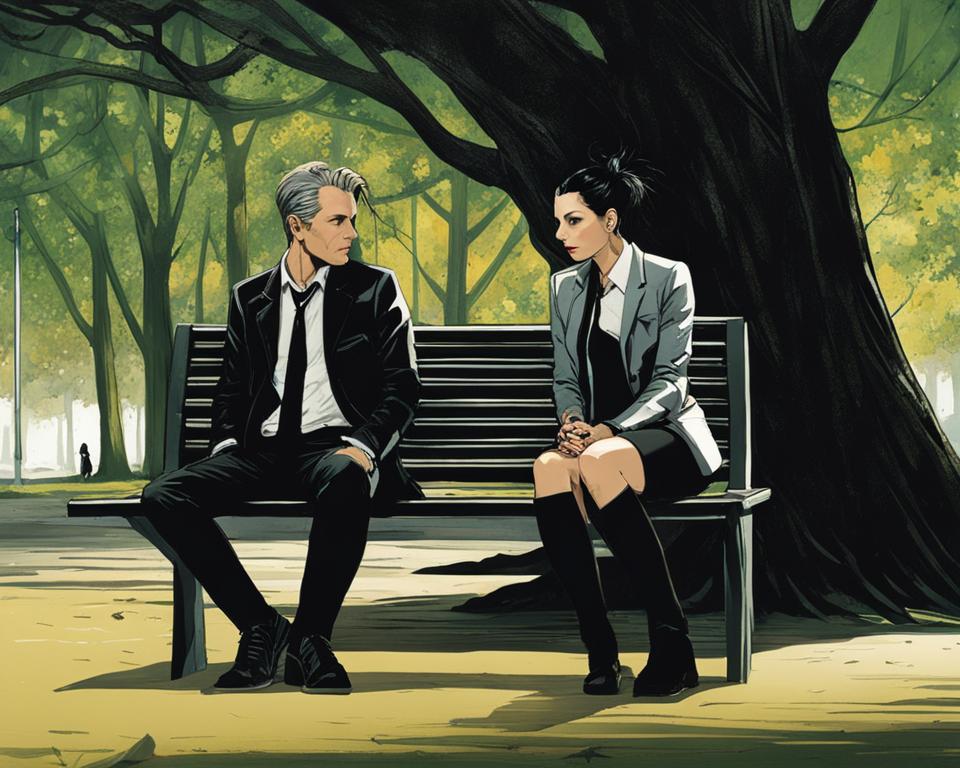Welcome to our audiobook review of “The Girl Who Kicked the Hornets’ Nest” by Stieg Larsson, the third and final book of the Millennium series. Stieg Larsson was a Swedish author known for his activism against racism and fascism. His books focus on relevant societal issues and explore the darker side of human nature.
“The Girl Who Kicked the Hornets’ Nest” was published posthumously and became an instant bestseller. The audiobook version, narrated by Saul Reichlin, is a gripping and powerful rendition of the book that will transport you to the world of Lisbeth Salander and Mikael Blomkvist.
Key Takeaways:
- Stieg Larsson was an acclaimed Swedish author who explored relevant societal issues in his books.
- “The Girl Who Kicked the Hornets’ Nest” is the final book in the Millennium series and was published posthumously.
- The audiobook version, narrated by Saul Reichlin, is a powerful and gripping rendition of the book.
- Larsson’s storytelling delves into darker human behavior and the book explores relevant societal issues.
- The book is an instant bestseller and has overarching impact within the literary community.
About the Author, Stieg Larsson
Stieg Larsson was a Swedish author, journalist, and activist born in 1954. Before pursuing his passion for writing, Larsson worked as a graphic designer and a journalist for the Swedish news agency TT.
Larsson became a household name with the publication of his internationally acclaimed Millennium series, which includes “The Girl with the Dragon Tattoo,” “The Girl Who Played with Fire,” and “The Girl Who Kicked the Hornets’ Nest.” These novels feature the enigmatic protagonist Lisbeth Salander, and have been translated into over 50 languages and sold over 80 million copies worldwide.
Larsson’s writing style is characterized by his sharp social commentary, intricate plotlines, and his ability to create complex, multidimensional characters. He was a passionate advocate for social justice and equality, which is reflected in the themes and motifs throughout his work.
“I want to send a message to society that says, ‘We women are not going to take it anymore. Violence against women has become too common. Men who hate women use all sorts of methods to degrade and destroy us as human beings.'” – Stieg Larsson
Larsson tragically passed away in 2004 before the publication of his Millennium series, leaving behind an unfinished manuscript for a fourth book. His legacy lives on through his writing and the impact he made on the world.
Influences and Inspiration
Larsson’s background as a journalist heavily influenced his writing, as he drew inspiration from the real-life events and stories he reported on. He was also a fan of crime fiction, citing authors such as Agatha Christie and Raymond Chandler as his literary influences.
Larsson was also deeply committed to social justice, and his writing often touched on issues such as gender inequality, racism, and political corruption. He was an active member of various left-wing groups and founded the Swedish Expo Foundation, which aimed to combat racism and xenophobia in Sweden.
Overall, Stieg Larsson was a passionate and talented writer who used his platform to amplify the issues he cared about. His contributions to the literary world and his impact on society will not be soon forgotten.
The Millennium Series Overview
The Millennium series is a gripping and intense crime thriller saga that spans over three books. Written by Swedish author Stieg Larsson, it showcases gritty and audacious storytelling that takes readers on a journey through the dark underbelly of Swedish society.
The series features a host of intriguing characters, but the central protagonist is the enigmatic and complex Lisbeth Salander. Her captivating persona and dark backstory have contributed to defining the series. Alongside the series’ other key characters, such as journalist Mikael Blomkvist, Salander brings a unique and compelling dynamic to the story.
The recurring themes throughout the series include corruption, sexual violence, and abuse of power, all of which are explored in depth and with great sensitivity. The books are particularly notable for their social commentary, which makes them as relevant today as when they were first published.
“The Millennium series is a defining work of the Nordic noir genre, combining taut suspense with social commentary and unforgettable characters.” – The Guardian
Plot Summary of “The Girl Who Kicked the Hornets’ Nest”
“The Girl Who Kicked the Hornets’ Nest” by Stieg Larsson is an electrifying page-turner that continues the story of Lisbeth Salander, a brilliant and enigmatic hacker, and Mikael Blomkvist, a crusading investigative journalist. The novel picks up right where the previous installment left off, with Lisbeth recovering in the hospital from the traumatic events that transpired in the Hornets’ Nest apartment complex.
As Lisbeth’s trial for multiple charges looms, Mikael is determined to clear her name and expose the powerful individuals who seek to silence her. With the help of his colleagues at Millennium magazine and an unlikely ally in Lisbeth’s long lost twin sister, Camilla, Mikael embarks on a dangerous journey to uncover the truth.
The plot of “The Girl Who Kicked the Hornets’ Nest” is filled with twists and turns, as Mikael and Lisbeth navigate a labyrinth of conspiracies and corruption that extends to the highest levels of government and industry. The novel culminates in a thrilling courtroom showdown where the truth is finally revealed, and justice is served.
The major events in “The Girl Who Kicked the Hornets’ Nest” include Lisbeth’s recovery from her injuries, Mikael’s investigation into the Section and the Zalachenko affair, Lisbeth’s trial and subsequent escape, and the final reckoning between Lisbeth and her adversaries. With its gripping plot and complex characters, “The Girl Who Kicked the Hornets’ Nest” is a stunning conclusion to the Millennium series that will leave readers on the edge of their seats and longing for more.
Audiobook Narration
One of the key components that make the audiobook version of “The Girl Who Kicked the Hornets’ Nest” such a compelling listen is the stellar narration by actor Simon Vance. With his engaging delivery and expert command of character voices, Vance brings to life the rich tapestry of personalities that populate Stieg Larsson’s world.
From the fierce and enigmatic Lisbeth Salander to the tenacious journalist Mikael Blomkvist, Vance captures each character’s unique voice and personality with a deftness that draws listeners deeper into the story. His nuanced performance lends an extra layer of depth to the already complex characters, making them feel more real and relatable.
“Simon Vance’s narration is simply exceptional, delivering a gripping and unforgettable listening experience that will keep you on the edge of your seat from beginning to end.”
Vance’s impeccable pacing and masterful use of tone and inflection ensure that the tension never wavers, even as the story weaves through multiple subplots and intricate political machinations. Whether you’re a fan of the Millennium series or simply looking for a thrilling audiobook experience, Simon Vance’s performance is not to be missed.
Character Development

The character development in “The Girl Who Kicked the Hornets’ Nest” is one of the book’s strongest elements. Lisbeth Salander, the book’s enigmatic protagonist, experiences significant personal growth throughout the story. As we learn more about her troubled past and witness her bravery in the face of adversity, she reveals a softer side that contradicts the tough exterior she presents to the world.
Mikael Blomkvist, a journalist and key character in the series, also experiences significant changes throughout the book. He becomes more morally ambiguous as he navigates complex political and personal relationships, making him a more unpredictable and dynamic character.
“Larsson’s skillful writing allows us to see both the strengths and flaws of his characters, making them feel realistic and relatable.”
Overall, “The Girl Who Kicked the Hornets’ Nest” provides a satisfying and well-rounded conclusion to the Millennium series, with character development that keeps readers invested in the story until the very end.
Themes and Motifs
One of the most striking aspects of “The Girl Who Kicked the Hornets’ Nest” is its powerful exploration of various themes and motifs. Throughout the book, Stieg Larsson boldly tackles issues such as social commentary, gender dynamics, and corruption in society.
The novel brilliantly portrays the ways in which power and influence can corrupt even the most well-intentioned individuals, as well as the deeply ingrained prejudices that exist within our societies. In particular, Larsson uses the character of Lisbeth Salander to offer a scathing critique of patriarchal systems and the ways in which they disadvantage women.
Another crucial theme in the book is the nature of justice, and the lengths to which some people are willing to go in order to uphold it. The novel presents a complex and nuanced picture of justice, illustrating the difference between revenge and true justice, and the importance of balancing the two.
Overall, the themes and motifs in “The Girl Who Kicked the Hornets’ Nest” make it a thought-provoking and impactful work of fiction, offering readers a glimpse into the complexities of our society and the struggles of those who fight against injustice.
Writing Style and Pacing
Stieg Larsson’s writing style in “The Girl Who Kicked the Hornets’ Nest” is characterized by its fast-paced, descriptive prose that drives the narrative forward. The book is masterfully crafted in its execution, with Larsson’s carefully chosen words and phrases painting a vivid picture of the characters and their surroundings.
The pacing of the book is impeccable, with a constant sense of tension and urgency that keeps the reader engaged from start to finish. The story seamlessly weaves together multiple threads, building towards a thrilling climax that delivers on all fronts.
“Larsson’s prose is both gripping and evocative, with an expert balance of detail and action that keeps the story moving at a breakneck pace.”
The author’s use of storytelling techniques, such as foreshadowing and tense changes, adds an additional layer of depth to the narrative. Larsson’s writing is both engaging and thought-provoking, eliciting a range of emotions from readers and leaving a lasting impression long after the final page is turned.
Critical Reception and Awards
Upon its release, “The Girl Who Kicked the Hornets’ Nest” received widespread critical acclaim, cementing Stieg Larsson’s legacy as a master of the thriller genre. The novel’s gripping plot, well-drawn characters, and social commentary were praised by readers and critics alike, solidifying its status as a must-read for fans of the series and newcomers alike.
The book went on to receive several prestigious accolades, including the Glass Key Award for Best Nordic Crime Novel and the Swedish Academy of Crime Writers’ Award for Best Swedish Crime Novel. Larsson’s work has also been recognized internationally, with the Millennium series selling over 80 million copies worldwide and being translated into over 50 languages.
The critical reception and awards bestowed upon “The Girl Who Kicked the Hornets’ Nest” speak to the enduring quality and impact of Larsson’s work, solidifying his place as one of the most important and influential authors of the 21st century.
Impact and Legacy
Since the release of “The Girl Who Kicked the Hornets’ Nest” and the Millennium series, its impact on the thriller genre and popular culture has been undeniable. Stieg Larsson’s unique storytelling style and interesting characterization had a significant influence on numerous writers that followed his works, making him an icon of the genre.
The legacy of the Millennium series is so strong that it transcends the books themselves. The franchise sold over 80 million copies worldwide, making it one of the best-selling book series of all time. Moreover, the book series has spawned numerous adaptations, including films and tv-shows, which further proves the widespread popularity of the Millennium series.
The characters created by Stieg Larsson will forever be in the hearts of readers and will continue to influence thriller writers for generations to come.
The Millennium series remains a prime example of high-quality writing in the thriller genre, as well as an excellent representation of Swedish and Scandinavian cultural values. Its impact on popular culture and the thriller genre is undeniable, making “The Girl Who Kicked the Hornets’ Nest” a true masterpiece that transcends time and place, leaving a worldwide legacy for generations to come.
Conclusion
Overall, “The Girl Who Kicked the Hornets’ Nest” audiobook is a thrilling conclusion to Stieg Larsson’s Millennium series. The plot is engaging and fast-paced, with satisfying resolutions to the ongoing conflicts and character arcs.
The audiobook narration is well-done, with a skilled performer bringing the characters and story to life. Lisbeth Salander, in particular, shines as a complex and intriguing protagonist.
Larsson’s impressive writing style offers a perfect balance of descriptive language and fast-paced action, making for a compelling read from start to finish.
With its exploration of themes such as corruption and gender dynamics, “The Girl Who Kicked the Hornets’ Nest” offers both entertainment and social commentary. Its impact and legacy are undeniable, solidifying its place as a classic in the thriller genre.
Overall, this audiobook is highly recommended for fans of the Millennium series and those looking for a thrilling and thought-provoking read.



